-
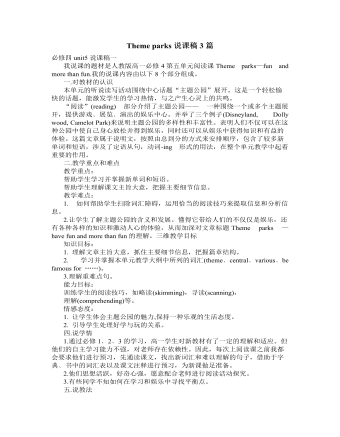
人教版高中英语必修4Theme parks说课稿3篇
The oldest and the most popular park in the worldenjoy the exciting activities thereget close to the life-size cartoon characters like Mickey Mouse and Donald Duck Step 3 Pre-reading1.What do you suppose a theme park is ?2.What do you think you can see in a theme park?(1.It is a kind of amusement park which has a certain theme – that the whole park is based on. 2.buildings, castles, statues, rare animals and birds, and so on.) Step 4 Reading ----- Theme Parks –---- Fun and More Than Fun1.Predict : Read the title and the pictures on P. 34 and PredictWhat is the meaning of the title “Theme Park – Fun and more than fun”?(The title means that theme parks are fun to visit, but that they can also be educational and can offer useful information.)2.Skimming Fast read and answer:What activities can we take in a theme park?Amusement park: Bumper car Merry-go-round slide bungee jumping Free-fall rides Horror films Pirate ship Ferris wheel roller coaster3.Scanning Read again and you will find various theme parks are mentioned in the passage . Then what are they ?Theme parks: Sports theme park History theme park Culture theme park Marine or Ocean theme Park Future park Science theme park Disneyland4.Careful reading and find the main idea of each paragraph:THEME PARKS---- entertaining/ educationalPara.1 Traditional parks are places to go for relaxation and to have time away from our busy lives.Para.2 Theme parks are different They’re large and full of things to do, see and buy.Para.3 Theme parks are built around a single idea or theme. One example is a sports park.Para.4 Another kind of theme park is historical more and cultural and can be educational.Para.5 Disneylandwas the first theme park. It is based on the fantasy life and characters of Disney’s films.Para.6 Some examples of educational theme parks include sea world parks and science parks.
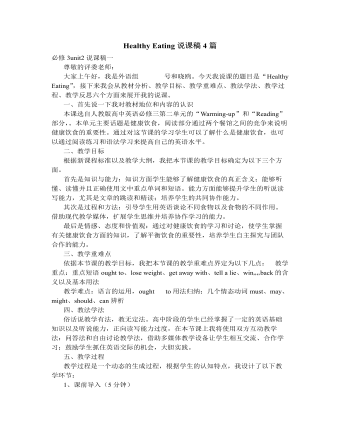
人教版高中英语必修3Healthy Eating说课稿4篇
Language learning needs a context, which can help the learners to understand the language and then can product comprehensible output, so computer has the advantages to make the materials attractive.Part 3 Learning MethodsTask-based, self-dependent and cooperative learningPart 4 Teaching ProcedureStep One Lead-in“Interest is the best teacher.” Therefore, at the very beginning of the class, I should spark the students’ mind to focus on the centre topic “the band”. I’ll show some pictures of food to attract their attention and then bring some questions.Question:What kind of food they like?What should go into a good meal?The answers must relate to the diet. After this, the students will be eager to know something about a balance diet and this is the very time to naturally lead the class into Step 2Step 2 Reading for information: skimming and scanning In this step, I use Task-based Language Teaching method, which can give students a clear and specific purpose while skimming and scanning the context.Task 1 General ideaThe students will be asked to just glance at the title and the pictures of the passage, and then guess what they will read in the text. And they’ll be divided into groups of four to have a discussion.The purpose is to inspire the students to read actively, not passively. In addition, the task is to develop the students’ reading skill by making prediction and to encourage the students to express their thoughts in English and cooperate with each other.Task 2 Main idea of each paragraphCooperative learning can raise the students’ interest and create an atmosphere of achievement. Based on this theory, I divide the whole class into 4 groups to skim the whole text and get the main idea of each paragraph.
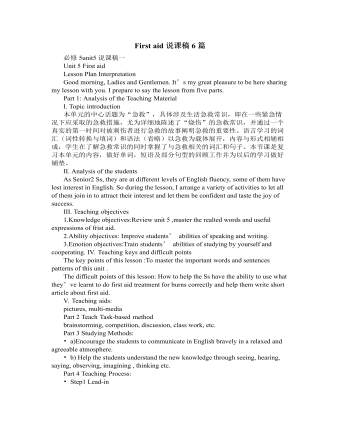
人教版高中英语必修5First aid说课稿6篇
In this class, I have 3 teaching aims, that is, knowledge aims, ability aims and emotion aims.1) Knowledge-Teach students new words and expressions, such as temporary, bleed,sprain choke, first aid, fall ill and so on.-Enable students to have a better understanding for some basic knowledge of first aid.2) Ability-Train students’ speaking, reading and writing abilities by different teaching activities, such as skimming, comprehending, team work, role play, retelling and writing.-Develop students’ reading strategy on how to move general idea to specific information.3) Emotion-Promote students’ awareness of giving first aid.- Cultivate students’ creativities.Then let’s come to my teaching methods and activities.III. Teaching methods and activities:To achieve different teaching aims, various kinds of teaching methods and activities will be adopted throughout this period, such as TBL (task-based learning), skimming, team work, brainstorm and others, which can offer students opportunities to fulfill tasks in which they can use language to achieve a specific outcome.IV. Teaching aids:Computer and blackboardV. Teaching important points:1) Make students have a clear mind for the structure of the text.2) Help students understand the theme of the text.VI. Teaching difficulties:1) So many new words may affect students’ understanding.2) How to get students to know about the functions of the skin and thecauses, characteristics and treatments for different degree burns,and the knowledge about giving first aid. VII. Blackboard design:
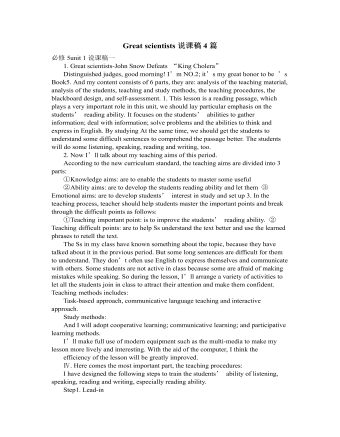
人教版高中英语必修5Great scientists说课稿4篇
通过写文章梗概,培养学生综合运用语言的能力,学习用恰当的英语描述科学家的故事。这是本课的教学难点。教师可以使用完形填空的方式来帮助学生整理语篇,从而来降低难度。本课的教学重点的突破方法是:在阅读前,让学生初步了解得出科学观点所需要的基本程序,从而轻松而自然地导入文章的阅读;在阅读过程中,由易到难设计快速阅读和精读的问题,层层推进各种阅读活动,让学生对阅读内容从整体感知到细节理解,最后深层读懂整篇文章,同时加强阅读策略的指导,让每个学生都主动参与课堂教学活动,最终达到提高阅读能力的目的。Step 4 Post-readingGroup Activities四人小组共同合作,在老师的适当指导下,就以下2个问题展开讨论,让学生就所知、所学、所感和所想融入话题,然后抽若干同学代表作小组发言。1. What do you think about John Snow, and what should we learn from him?2. Cholera was 19th century disease, which two diseases are similar to cholera today? Why?

人教版高中英语必修5Life in the Future说课稿5篇
Good afternoon, everyone. It’s my great pleasure to be here sharing my lesson with you. The content of my lesson is Senior English for China Book5 Unit 3 Life in the Future. I’ll be ready to begin this lesson from six parts: Analysis of the teaching material, Analysis of the students, Teaching aims and important and difficult points, Teaching methods and aids, Teaching procedures, and Blackboard design. First, let me talk about the teaching material.Part 1 Analysis of the Teaching Material:This unit is about what human beings’ life will be like in about one thousand years. By studying of this unit, we’ll Enable the students to know the changes in humans’ life and some new inventions bringing about the change and develop the interest in science. This lesson plays an important part in the English teaching in this unit. This is an important lesson in Book Five. From this lesson, it starts asking the Ss to grasp contents of each passage. Therefore, this lesson is in the important position of the teaching material. If the Ss can learn it well, it will be helpful to make the Ss learn the rest of this unit.Part 2 Analysis of the SsAs Senior2 Ss, they are at different levels of English fluency, some of them have lost interest in English. So during the lesson, I arrange a variety of activities to let all of them join in to attract their interest and let them be confident and taste the joy of success.
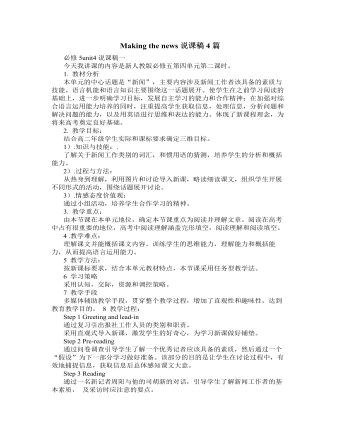
人教版高中英语必修5Making the news说课稿4篇
今天我们来介绍一下必修五第四单元的授课方式。这个单元的题目是Making the news。应该是学生比较感兴趣的话题,学生往往对新闻工作充满好奇,所以我们可以利用这个机会多设计一些师生互动和学生互动,来激发起学习的积极性,提高学习效率。同时我们可以利用这个单元不仅帮助学生掌握语言知识,培养语言能力,同时让其了解新闻工作的重要性,培养起社会智能感。这个单元分为六个课时,它的教学目标是这样的:语言目标是掌握词汇表中的常用单词和短语,掌握倒装句的一些基本用法。 技能目标是能初步掌握约会的基本句型并在真实的场景下正确运用。新闻报道类文章的写作技能。采访的基本规范和沟通技能。情感目标是对新闻报道的客观性和真实性有更好的理解。对新闻记者的职业有更深入的了解,并能体会其工作的重要性。下面我们来介绍一下第一课时的授课方式,第一课的教学目标是这样的第一课时的教学目标语言目标:单词:Occupation, journalist, editor, photographer, curious, personality, enthusiasm
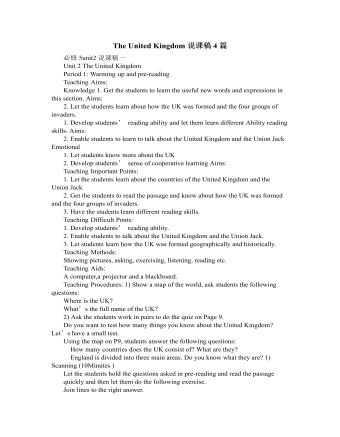
人教版高中英语必修5The United Kingdom说课稿4篇
Teaching Aims:Knowledge 1. Get the students to learn the useful new words and expressions in this section. Aims:2. Let the students learn about how the UK was formed and the four groups of invaders.1. Develop students’ reading ability and let them learn different Ability reading skills. Aims:2. Enable students to learn to talk about the United Kingdom and the Union Jack Emotional 1. Let students know more about the UK2. Develop students’ sense of cooperative learning Aims:Teaching Important Points:1. Let the students learn about the countries of the United Kingdom and the Union Jack2. Get the students to read the passage and know about how the UK was formed and the four groups of invaders.3. Have the students learn different reading skills.Teaching Difficult Ponts:1. Develop students’ reading ability.2. Enable students to talk about the United Kingdom and the Union Jack.3. Let students learn how the UK was formed geographically and historically.Teaching Methods:Showing pictures, asking, exercising, listening, reading etc.Teaching Aids:A computer,a projector and a blackboard.Teaching Procedures: 1) Show a map of the world, ask students the following questions:Where is the UK?What’s the full name of the UK?2) Ask the students work in pairs to do the quiz on Page 9.Do you want to test how many things you know about the United Kingdom? Let’s have a small test.Using the map on P9, students answer the following questions:?How many countries does the UK consist of? What are they??England is divided into three main areas. Do you know what they are? 1) Scanning (10Minutes )Let the students hold the questions asked in pre-reading and read the passagequickly and then let them do the following exercise.Join lines to the right answer.
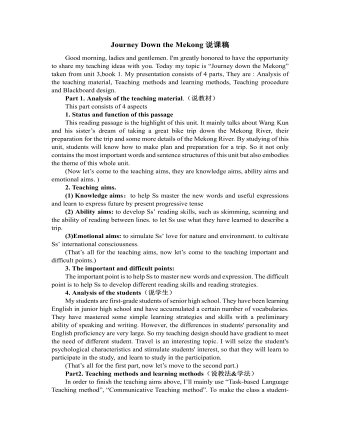
人教版高中英语必修1Journey Down the Mekong说课稿
2. let the Ss complete the forms paragraph by paragraph. Purpose here is to help Ss to get the habit of reading a passage as a whole, and pay attention to the organization of the text, as a result the Ss will fully understand the whole passage.3. ask Ss to retell the passage with the help of the key words in the form.Since the Ss in the class are in different levels, so I let them to fill in the blank to understand the meaning of the words and phrases better. ( That’s all for the while-reading. Now let’s move to the fifth step.)Step V: Post-reading (10mins) ---DiscussionIn this part students are asked to discuss in groups and list Wang Kun’s and Wang Wei’s attitudes about the trip. After that, Ss are encouraged to express their attitudes with the whole class. Collect their answers and don’t forget to praise them even if their answers may not be perfect.In this activity, discussion provides a vivid and active learning environment for Ss to communicate in English with newly learned language items. (Finally it comes to the homework.)StepⅥ: Homework (1min)1. Ss are required to read the text again after class and figure out the meaning of some complex sentences.2. Do the exercises on P19; This can help Ss to consolidate what they’ve learnt and make preparation for the next lessonPart4. Blackboard design.(说板书设计)On the top, there is the title of this lesson. On the left, there are main ideas for each paragraph. On the right, there are some new words and expressions.Unit 3 Travel journalJourney down the MekongMain idea of each para.:Para1: deciding to take a great bike trip along the Mekong river.Para2: Different attitudes between Wang kun and Wang wei.
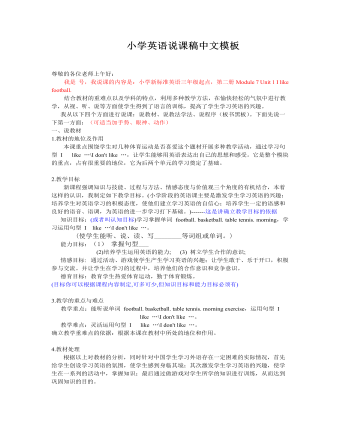
小学英语说课稿中文模板
一、说教材1.教材的地位及作用 本课重点围绕学生对几种体育运动是否喜爱这个题材开展多种教学活动,通过学习句型 I like …\I don't like …,让学生能够用英语表达出自己的思想和感受。它是整个模块的重点,占有很重要的地位,它为后两个单元的学习奠定了基础。 2.教学目标 新课程强调知识与技能、过程与方法、情感态度与价值观三个角度的有机结合,本着这样的认识,我制定如下教学目标。(小学阶段的英语课主要是激发学生学习英语的兴趣;培养学生对英语学习的积极态度,使他们建立学习英语的自信心;培养学生一定的语感和良好的语音、语调,为英语的进一步学习打下基础。)-------这是讲确立教学目标的依据 知识目标:(或者叫认知目标)学习掌握单词 football. basketball. tabletennis. morning,学 习运用句型 I like …\I don't like …。
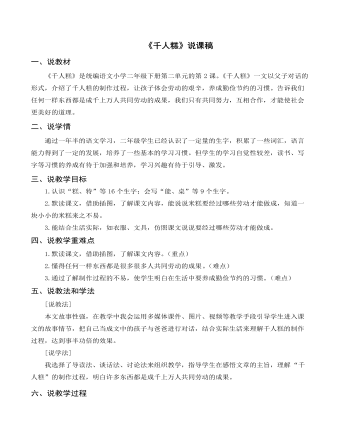
(说课稿)《千人糕》部编人教版二年级上册语文
四、说教学重难点1.默读课文,借助插图,了解课文内容。(重点)2.懂得任何一样东西都是很多很多人共同劳动的成果。(难点)3.通过了解制作过程的不易,使学生明白在生活中要养成勤俭节约的习惯。(难点)五、说教法和学法[说教法]本文故事性强,在教学中我会运用多媒体课件、图片、视频等教学手段引导学生进入课文的故事情节,把自己当成文中的孩子与爸爸进行对话,结合实际生活来理解千人糕的制作过程,达到事半功倍的效果。[说学法]我选择了导读法、谈话法、讨论法来组织教学,指导学生在感悟文章的主旨,理解“千人糕”的制作过程,明白许多东西都是成千上万人共同劳动的成果。
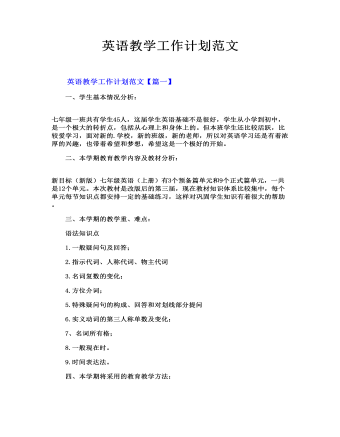
英语教学工作计划范文
1.用英语教英语(Teach English inEnglish); 英语毕竟是一门语言,训练的是学生的听、说、读、写、译的综合能力,在教学的过程中需要对学生的听、说、读、写、译的能力进行很多的训练,这就要求我们用英语来教英语,在课堂上对学生进行各种能力的训练。
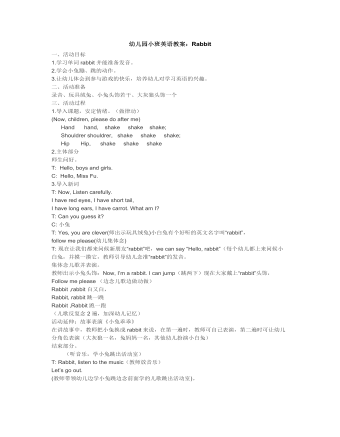
幼儿园小班英语教案:Rabbit
二、活动准备 录音、玩具绒兔、小兔头饰若干、大灰狼头饰一个 三、活动过程 1.导入课题,安定情绪。(做律动) (Now, children, please do after me) Hand hand, shake shake shake; Shouldrer shouldrer, shake shake shake; Hip Hip, shake shake shake2.主体部分 师生问好。 T: Hello, boys and girls. C: Hello, Miss Fu. 3.导入新词 T: Now, Listen carefully. I have red eyes, I have short tail, I have long ears, I have carrot. What am I?T: Can you guess it? C: 小兔 T: Yes, you are clever(师出示玩具绒兔)小白兔有个好听的英文名字叫“rabbit”,follow me please(幼儿集体念)
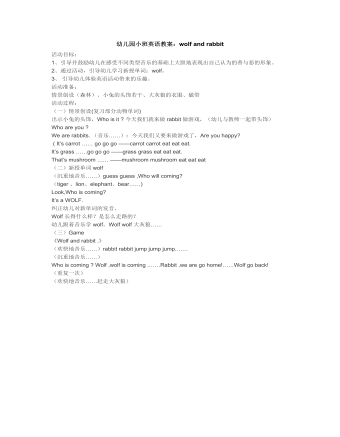
幼儿园小班英语教案:wolf and rabbit
2、通过活动,引导幼儿学习新授单词:wolf。 3、 引导幼儿体验英语活动带来的乐趣。 活动准备: 情景创设(森林)、小兔的头饰若干、大灰狼的衣服、磁带 活动过程: (一)情景创设(复习部分动物单词) 出示小兔的头饰,Who is it ? 今天我们就来做rabbit做游戏,(幼儿与教师一起带头饰) Who are you ? We are rabbits. (音乐……):今天我们又要来做游戏了,Are you happy? ( It’s carrot …… go go go ——carrot carrot eat eat eat.It’s grass ……go go go ——grass grass eat eat eat.That’s mushroom …… ——mushroom mushroom eat eat eat(
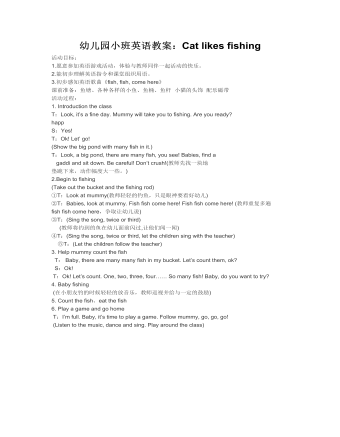
幼儿园小班英语教案:Cat likes fishing
3.初步感知英语歌曲《fish, fish, come here》 课前准备:鱼塘、各种各样的小鱼、鱼桶、鱼杆 小猫的头饰 配乐磁带 活动过程: 1. Introduction the class T:Look, it’s a fine day. Mummy will take you to fishing. Are you ready?happ S:Yes! T:Ok! Let’ go!(Show the big pond with many fish in it.)T:Look, a big pond, there are many fish, you see! Babies, find a gaddi and sit down. Be careful! Don’t crush!(教师先找一块地 垫跪下来,动作幅度大一些。)
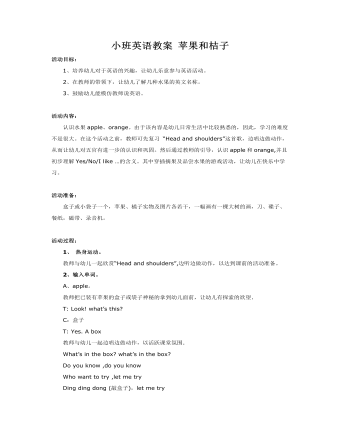
小班英语教案 苹果和桔子
2、在教师的带领下,让幼儿了解几种水果的英文名称。3、鼓励幼儿能模仿教师说英语。 活动内容: 认识水果apple、orange。由于该内容是幼儿日常生活中比较熟悉的,因此,学习的难度不是很大。在这个活动之前,教师可先复习 “Head andshoulders”这首歌,边唱边做动作,从而让幼儿对五官有进一步的认识和巩固。然后通过教师的引导,认识apple和orange,并且初步理解Yes/No/I like …的含义。其中穿插摘果及品尝水果的游戏活动,让幼儿在快乐中学习。 活动准备: 盒子或小袋子一个,苹果、橘子实物及图片各若干,一幅画有一棵大树的画,刀、碟子、餐纸,磁带、录音机。活动过程:1、热身运动。 教师与幼儿一起欣赏“Head andshoulders”,边听边做动作,以达到课前的活动准备。
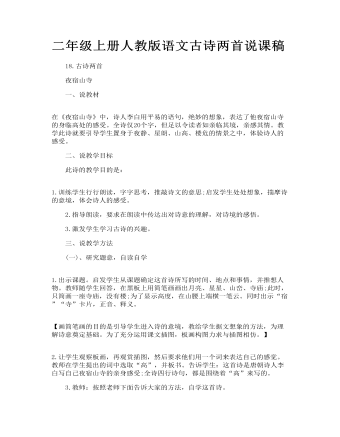
二年级上册人教版语文古诗两首说课稿
二、说教学目标 此诗的教学目的是: 1.训练学生行行朗读,字字思考,推敲诗文的意思;启发学生处处想象,揣摩诗的意境,体会诗人的感受。 2.指导朗读,要求在朗读中传达出对诗意的理解,对诗境的感悟。 3.激发学生学习古诗的兴趣。 三、说教学方法 (一)、研究题意,自读自学 1.出示课题。启发学生从课题确定这首诗所写的时间、地点和事情,并推想人物。教师随学生回答,在黑板上用简笔画画出月亮、星星、山峦、寺庙;此时,只简画一座寺庙,没有楼;为了显示高度,在山腰上端横一笔云。同时出示“宿”“寺”卡片,正音、释义。 【画简笔画的目的是引导学生进入诗的意境,教给学生据文想象的方法,为理解诗意奠定基础。为了充分运用课文插图,板画构图力求与插图相仿。】 2.让学生观察板画,再观赏插图,然后要求他们用一个词来表达自己的感觉。教师在学生提出的词中选取“高”,并板书。告诉学生:这首诗是唐朝诗人李白写自己夜宿山寺的亲身感受;全诗四行诗句,都是围绕着“高”来写的。
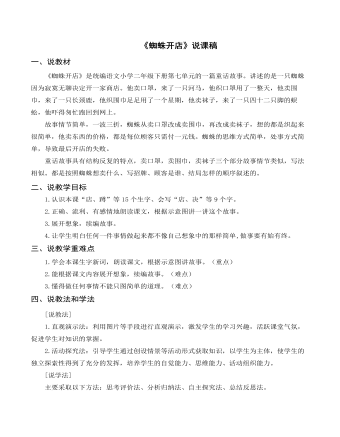
(说课稿)《 蜘蛛开店》部编人教版二年级上册语文
(二)初读故事,学习生字新词。1.打开课本大声朗读课文,遇到不认识的字,我们该怎么办?(借助拼音、查字典、寻求他人帮助等)【设计意图】帮学生提供学习方法,鼓励学生自主识字 2.老师在读课文时,也遇到了“拦路虎”,谁来帮帮我?(出示带拼音的生字)3.去掉拼音,你还能认识他们吗?谁来当小老师领着大家认一认?4.自己试着读一读,你是用什么办法可以把它们记得更牢固? 5.同学们的识字方法真多,相信你们一定把这些字都认识了,我们来开火车读一读吧?6.生字宝宝很调皮分别找了个好朋友让我们认一认,女生先来认一认?男生再来认一认。 7.词语宝宝真有趣,跑到句中,谁能读?出示带有生字的句子,指导朗读。①有一只蜘蛛,每天蹲在网上等着小飞虫落在上面,好寂寞,好无聊啊。②卖什么呢?就卖口罩吧,因为口罩织起来很简单。③口罩好难织啊,蜘蛛用了一整天的工夫,终于织完了。 ④第二天,蜘蛛的招牌又换了,上面写着:“袜子编织店,每位顾客只需付一元钱。” ⑤可是,蜘蛛看到顾客后,却吓得匆忙跑回网上。原来那位顾客竟是一条四十二只脚的蜈蚣。【设计意图】本环节出示的句子都是有代表性的句子,除了句子中都含有本课的生字外,又能让学生在读句子中初步感悟课文内容。
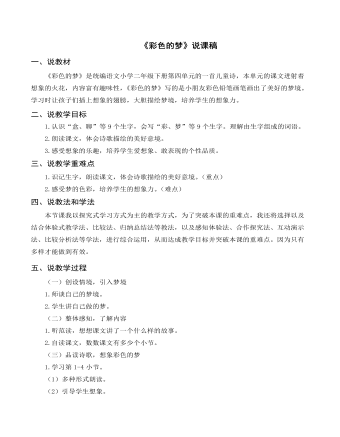
(说课稿)《彩色的梦》部编人教版二年级上册语文
一、说教材《彩色的梦》是统编语文小学二年级下册第四单元的一首儿童诗,本单元的课文迸射着想象的火花,内容富有趣味性,《彩色的梦》写的是小朋友彩色铅笔画笔画出了美好的梦境。学习时让孩子们插上想象的翅膀,大胆描绘梦境,培养学生的想象力。二、说教学目标1.认识“盒、聊”等9个生字,会写“彩、梦”等9个生字。理解由生字组成的词语。? 2.朗读课文,体会诗歌描绘的美好意境。? 3.感受想象的乐趣,培养学生爱想象、敢表现的个性品质。三、说教学重难点1.识记生字,朗读课文,体会诗歌描绘的美好意境。(重点) 2.感受梦的色彩,培养学生的想象力。(难点)
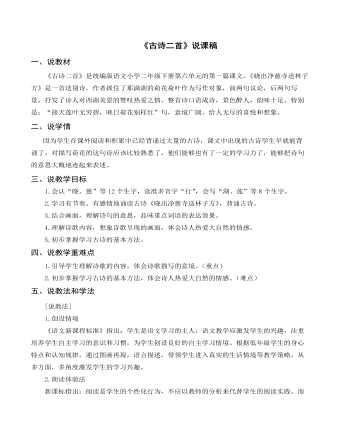
(说课稿)《 古诗二首》部编人教版二年级上册语文
一、说教材《古诗二首》是统编版语文小学二年级下册第六单元的第一篇课文。《晓出净慈寺送林子方》是一首送别诗,作者抓住了那满湖的荷花荷叶作为写作对象,前两句议论,后两句写景,抒发了诗人对西湖美景的赞叹热爱之情。整首诗口语成诗,景色醉人,韵味十足。特别是:“接天莲叶无穷碧,映日荷花别样红”句,意境广阔,给人无尽的喜悦和想象。二、说学情因为学生在课外阅读和积累中已经背诵过大量的古诗,课文中出现的古诗学生早就能背诵了,对描写荷花的这句诗应该比较熟悉了,他们能够也有了一定的学习力了,能够把诗句的意思大概地连起来表述。三、说教学目标1.会认“晓、慈”等12个生字,读准多音字“行”,会写“湖、莲”等8个生字。 2.学习有节奏、有感情地诵读古诗《晓出净慈寺送林子方》,背诵古诗。3.结合画面,理解诗句的意思,品味重点词语的表达效果。4.理解诗歌内容,想象诗歌呈现的画面,体会诗人热爱大自然的情感。5.初步掌握学习古诗的基本方法。
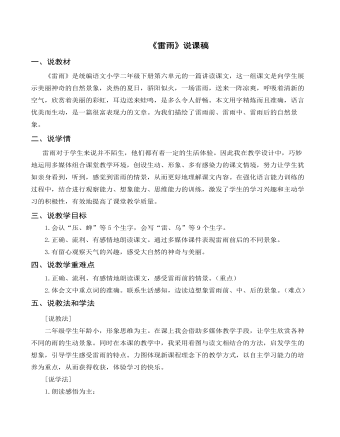
(说课稿)《 雷雨》部编人教版二年级上册语文
四、说教学重难点1.正确、流利、有感情地朗读课文,感受雷雨前的情景。(重点) 2.体会文中重点词的准确。联系生活感知,边读边想象雷雨前、中、后的景象。(难点)五、说教法和学法[说教法]二年级学生年龄小,形象思维为主。在课上我会借助多媒体教学手段,让学生欣赏各种不同的雨的生动景象。同时在本课的教学中,我采用看图与读文相结合的方法,启发学生的想象,引导学生感受雷雨的特点。力图体现新课程理念下的教学方式,以自主学习能力的培养为重点,从而获得收获,体验学习的快乐。?[说学法]1.朗读感悟为主:? “新课标”指出:学生是学习的主体。在教学中不能以教师的分析代替学生的阅读实践。要珍视学生的独特的感受。阅读也是低年级教学最常用的方法,学生在读中积累,在读中感悟,在读中形成语感。而本课语言精炼而生动,学生要在读中去感悟。2.合作探究法:? “新课标”明确指出:要变单一、被动、接受的学习方式为合作、主动、探究的学习方式。《雷雨》这一篇课文很明确地分为雷雨前、雷雨中、雷雨后这三部分,所以我会在组织全班学习完第一部分后,就组织学生合作学习探究第二、第三部分。? 3.勾画圈点法:让学生养成不动笔墨不读书的习惯。

